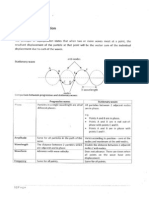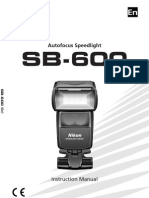225
225
Uploaded by
physicsdocsCopyright:
Available Formats
225
225
Uploaded by
physicsdocsCopyright
Available Formats
Share this document
Did you find this document useful?
Is this content inappropriate?
Copyright:
Available Formats
225
225
Uploaded by
physicsdocsCopyright:
Available Formats
MasteringPhysics: Assignment Print View
http://session.masteringphysics.com/myct/assignmentPrintView?assignme...
Test 7
Due: 11:59pm on Sunday, May 8, 2011
Note: You will receive no credit for late submissions. To learn more, read your instructor's Grading Policy [Switch to Standard Assignment View]
Exercise 34.19
The left end of a long glass rod 6.00 in diameter has a convex hemispherical surface 3.00 inside the rod. in radius. The refractive index of the glass is 1.60. The glass rod is immersed in oil left of the rod on the rod's axis is to be imaged 1.10 Part A How far from the left end of the rod must the object be located to form the image? ANSWER: = 40.9 Correct . An object placed to the
Exercise 34.22
The left end of a long glass rod 8.00 hemispherical surface with radius 4.00 in diameter, with an index of refraction 1.60, is ground to a concave . The glass rod is immersed in a liquid. An object 13.5 from the from the vertex inside the liquid.
vertex of the left end of the rod and on its axis is imaged at a point 8.50 Part A What is the index of refraction of the liquid? ANSWER: = 1.20 Correct
Problem 34.73
You are in your car driving on a highway at 23 mirror with radius of curvature 150 Part A If the image of the truck is approaching the vertex of the mirror at a speed of 1.0 away, what is the speed of the truck relative to the highway? Express your answer using two significant figures. when the truck is 2.0 when you glance in the passenger side mirror (a convex ) and notice a truck approaching.
1 of 11
5/12/2011 8:13 PM
MasteringPhysics: Assignment Print View
http://session.masteringphysics.com/myct/assignmentPrintView?assignme...
ANSWER:
= 36 Correct
Problem 34.86
A transparent rod 48.0 long and a refractive index of 1.56 is cut flat at the right end and rounded to a radius at the left end. An object is placed on the axis of the rod 12.8 hemispherical surface with a 14.7
to the left of the vertex of the hemispherical end. Part A What is the position of the final image, relative to the far end of the rod? ANSWER: = -55.8 Correct
Part B What is its magnification? ANSWER: = 1.95 Correct
Problem 34.95
One end of a long glass rod is ground to a convex hemispherical shape. This glass has an index of refraction of 1.51. When a small leaf is placed 20.2 in front of the center of the hemisphere along the optic axis, an image is formed inside the glass 9.09 Part A Where would the image be formed if the glass were now immersed in water (refractive index 1.33), but nothing else were changed? ANSWER: = 147 Correct from the spherical surface.
Problem 34.99
When an object is placed at the proper distance to the left of a converging lens, the image is focused on a screen 29.9 to the right of the lens. A diverging lens is now placed 16.0 to the right of the converging lens, and it is found that the screen must be moved 18.9 farther to the right to obtain a sharp image.
2 of 11
5/12/2011 8:13 PM
MasteringPhysics: Assignment Print View
http://session.masteringphysics.com/myct/assignmentPrintView?assignme...
Part A What is the focal length of the diverging lens? ANSWER: -24.1 Correct
Problem 34.100
A convex spherical mirror with a focal length of magnitude 24.0 mirror. An object 0.300 is placed 22.0 to the left of a plane tall is placed midway between the surface of the plane mirror and the vertex of
the spherical mirror. The spherical mirror forms multiple images of the object. Part A Where are the two images of the object formed by the spherical mirror that are closest to the spherical mirror? Enter your answers in ascending order separated by a comma. ANSWER: , = -13.9,-7.54 All attempts used; correct answer displayed
Part B How tall is each image? Enter your answers in ascending order separated by a comma. ANSWER: , = 0.126,0.206 All attempts used; correct answer displayed
Problem 34.101
A glass plate 3.80 thick, with an index of refraction of 1.60 and plane parallel faces, is held with its faces above a printed page. horizontal and its lower face 5.50 Part A Find the position of the image of the page formed by rays making a small angle with the normal to the plate. ANSWER: = 1.43 Correct
above the page
3 of 11
5/12/2011 8:13 PM
MasteringPhysics: Assignment Print View
http://session.masteringphysics.com/myct/assignmentPrintView?assignme...
Problem 35.50
Consider a two-slit interference experiment in which the two slits are of different widths. As measured on a distant screen, the amplitude of the wave from the first slit is , while the amplitude of the wave from the second slit is 2 . Part A Show that the intensity at any point in the interference pattern is
where and
is the phase difference between the two waves as measured at a particular point on the screen is the maximum intensity in the pattern.
Essay answers are limited to about 500 words (3800 characters maximum, including spaces). ANSWER: My Answer:
Part B Graph versus .
ANSWER:
View Answer Requested
Part C What is the minimum value of the intensity? Express your answer in terms of ANSWER: = Correct .
Part D For which values of does it occur?
4 of 11
5/12/2011 8:13 PM
MasteringPhysics: Assignment Print View
http://session.masteringphysics.com/myct/assignmentPrintView?assignme...
ANSWER:
Correct
Exercise 35.3
A radio transmitting station operating at a frequency of 125 phase. Antenna is 8.95 to the right of antenna has two identical antennas that radiate in between the antennas and along . . Consider point
the line connecting them, a horizontal distance Part A For what values of
to the right of antenna
will constructive interference occur at point
Enter your answers in ascending order separated by commas. ANSWER: = 0.875,2.08,3.28,4.48,5.68,6.88,8.08 Correct
Exercise 35.22: GPS Transmission
The GPS (Global Positioning System) satellites are approximately 5.18 low-power signals, one of which is at 1575.42 satellite, you put two 1575.42 across and transmit two (in the UHF band). In a series of laboratory tests on the
UHF transmitters at opposite ends of the satellite. These broadcast in
phase uniformly in all directions. You measure the intensity at points on a circle that is several hundred meters in radius and centered on the satellite. You measure angles on this circle relative to a point that lies along the centerline of the satellite (that is, the perpendicular bisector of a line which extends from one transmitter to the other). At this point on the circle, the measured intensity is 2.00 . Part A At how many other angles in the range is the intensity also 2.00 ?
Express your answer using two significant figures. ANSWER: = 27 Correct
Part B Find the four smallest( positive) angles in the range for which the intensity is 2.00 .
5 of 11
5/12/2011 8:13 PM
MasteringPhysics: Assignment Print View
http://session.masteringphysics.com/myct/assignmentPrintView?assignme...
Enter your answers in ascending order separated by commas. ANSWER: = 2.11,4.22,6.33,8.44 Correct
Part C What is the intensity at a point on the circle at an angle of 4.05 from the centerline?
ANSWER:
= 1.88 Correct
Problem 35.39
The radius of curvature of the convex surface of a planoconvex lens is 91.0 . The lens is placed convex side down on a perfectly flat glass plate that is illuminated from above with red light having a wavelength of 610 . Part A Find the diameter of the second bright ring in the interference pattern. ANSWER: = 1.82 Correct
Problem 35.60
After a laser beam passes through two thin parallel slits, the first completely dark fringes occur at the original direction of the beam, as viewed on a screen far from the slits. Part A What is the ratio of the distance between the slits to the wavelength of the light illuminating the slits? ANSWER: with
= 1.81 Correct
Part B What is the smallest positive angle, relative to the original direction of the laser beam, at which the intensity of the light is the maximum intensity on the screen?
6 of 11
5/12/2011 8:13 PM
MasteringPhysics: Assignment Print View
http://session.masteringphysics.com/myct/assignmentPrintView?assignme...
ANSWER:
= 12.7 Correct
Problem 35.61
The index of refraction of a glass rod is 1.48 at coefficient of and varies linearly with temperature, with a . At 20.0 . The coefficient of linear expansion of the glass is
the length of the rod is 3.40
. A Michelson interferometer has this glass rod in one arm, and the rod is . The light source has wavelength
being heated so that its temperature increases at a rate of 5.00 = 599 Part A How many fringes cross the field of view each minute? ANSWER: = 15.6 fringes/minute Correct , and the rod initially is at .
Problem 35.55
A source of monochromatic light and a detector are both located in air a distance . Waves reaching above a horizontal directly from so that the plane sheet of glass, and are separated by a horizontal distance interfere with waves that reflect off the glass. The distance reflection is at close to normal incidence. Part A Show that the condition for constructive interference is destructive interference is , and the condition for
is small enough compared to
. (Hint: Take into account the phase change on reflection.)
Essay answers are limited to about 500 words (3800 characters maximum, including spaces). ANSWER: My Answer:
Part B Let 25 and 20 . What is the longest wavelength for which there will be constructive
interference? Express your answer using two significant figures.
7 of 11
5/12/2011 8:13 PM
MasteringPhysics: Assignment Print View
http://session.masteringphysics.com/myct/assignmentPrintView?assignme...
ANSWER:
= 68 Correct
Exercise 36.27
Laser light of wavelength 490 89.0 illuminates two identical slits, producing an interference pattern on a screen apart, and the third bright bands on either side of the from the slits. The bright bands are 1.00
central maximum are missing in the pattern. Part A Calculate the width of the slits. ANSWER:
5 = 1.4510 Correct
Part B Find the separation of the two slits (the distance between their centers). ANSWER:
5 = 4.3610 Correct
Problem 36.59: Angular Width of a Principal Maximum
Consider Part A Use the small-angle approximation (for in radians) to prove the following: For an intensity evenly spaced, narrow slits.
maximum that occurs at an angle , the intensity minima immediately adjacent to this maximum are at angles and , so that the angular width of the principal maximum is .
Essay answers are limited to about 500 words (3800 characters maximum, including spaces). ANSWER: My Answer:
Problem 36.64
In the equation ( , ), consider the case in which
8 of 11
5/12/2011 8:13 PM
MasteringPhysics: Assignment Print View
http://session.masteringphysics.com/myct/assignmentPrintView?assignme...
. Part A Show that eqaution reduces to with slit width 2 .
Essay answers are limited to about 500 words (3800 characters maximum, including spaces). ANSWER: My Answer:
Problem 36.74 Intensity Pattern of N Slits.
Part A Consider an arrangement of slits with a distance between adjacent slits. The slits emit coherently and is
in phase at wavelength . Show that at a time , the electric field at a distant point
where
is the amplitude at
of the electric field due to an individual slit,
is the
angle of the rays reaching is the distance from
(as measured from the perpendicular bisector of the slit arrangement), and is much larger than .
to the most distant slit. In this problem, assume that
Essay answers are limited to about 500 words (3800 characters maximum, including spaces). ANSWER: Answer Key: Each source can be thought of as a traveling wave evaluated at x=R with a maximum amplitude of E_0. However, each successive source will pick up an extra phase from its respective pathlength to point P. phi = 2*pi*(d*sin(theta)/lambda) which is just 2*pi the maximum phase, scaled by whatever fraction the path difference, d*sin(theta), is of the wavelength, lambda . By adding up the contributions from each source (including the accumulating phase difference) this gives the expression provided.
Part B To carry out the sum in part (a), it is convenient to use the complex-number relationship where . In this expression, is the real part of the complex number , and is its
imaginary part. Show that the electric field
is equal to the real part of the complex quantity
Essay answers are limited to about 500 words (3800 characters maximum, including spaces).
9 of 11
5/12/2011 8:13 PM
MasteringPhysics: Assignment Print View
http://session.masteringphysics.com/myct/assignmentPrintView?assignme...
ANSWER: Answer Key: Let sum(n,m, A_k) - summ of A_k, where n <= k<= m. exp(i*(k*R - omega*t +n*phi))=cos(kR-omega*t+n*phi)+ i*sin(kRomega*t+n*phi). The real part is just cos(kR-omega*t+n*phi). So, Re(sum(0, N-1,E_0*exp(i*(k*R - omega*t +n*phi)) )) = =sum(0, N-1,E_0*cos(i*(k*R - omega*t +n*phi)) ). But this is just E_0*cos(kR-omega*t) + E_0*cos(kR-omega*t+phi) + E_0*cos(kRomega*t+2*phi)+... ...+E_0*cos(kR-omega*t+(N-1)*phi).
Part C Using the properties of the exponential function that sum in part (b). Express your answer in terms of the variables ANSWER: = Answer Requested , , , , , and . and , find real part of the
Part D Use the result for the electric-field amplitude in part (c) to show that the intensity at an angle is
where
is the maximum intensity for an individual slit.
Essay answers are limited to about 500 words (3800 characters maximum, including spaces). ANSWER: Answer Key: I=(|E|_av)^2 = I_0*(sin(N*phi/2)/sin(phi/2))^2 (The cos^2 term goes to 1/2 in the time average and is included in the definition of I_0 .) I_0 ~ (E_0)^2/2
Part E Check the result in part (d) for the case your result differs from equation by a factor of 4.(Hint: Is . It will help to recall that . Explain why
, the expression for the intensity in two-source interference,
defined in the same way in both expressions?)
Essay answers are limited to about 500 words (3800 characters maximum, including spaces). ANSWER: Answer Key: N=2. I=I_0*(sin(N*phi/2)/sin(phi/2))^2 =
10 of 11
5/12/2011 8:13 PM
MasteringPhysics: Assignment Print View
http://session.masteringphysics.com/myct/assignmentPrintView?assignme...
=I_0*(2*sin(phi/2)*cos(phi/2))^2/(sin(phi/2))^2 = 4*I_0* (cos(phi/2))^2. Looking at equation I =1/2*epsilon_0*c*(E_p)^2 = 2*epsilon_0*c*E^2*(cos(phi/2))^2 I_0'~2*(E_0)^2 but for us I_0 ~ (E_0)^2/2 = I_0'/4.
Exercise 36.16
Laser light of wavelength 632.8 falls normally on a slit that is 0.0300 wide. The transmitted light is . viewed on a distant screen where the intensity at the center of the central bright fringe is 8.50 Part A Find the maximum number of totally dark fringes on the screen, assuming the screen is large enough to show them all. ANSWER: = 94 Correct
Part B At what angle does the dark fringe that is most distant from the center occur? ANSWER: = 82.5 Correct
Part C What is the maximum intensity of the bright fringe that occurs immediately before the dark fringe in part (b)? Approximate the angle at which this fringe occurs by assuming it is midway between the angles to the dark fringes on either side of it. ANSWER:
4 = 3.7610 Correct
Score Summary:
Your score on this assignment is 76.1%. You received 76.13 out of a possible total of 100 points.
11 of 11
5/12/2011 8:13 PM
You might also like
- 16Document68 pages16physicsdocs87% (23)
- Subjective Refraction Prescribing Glasses JCAHPODocument82 pagesSubjective Refraction Prescribing Glasses JCAHPOnonihalim100% (2)
- 22Document50 pages22physicsdocs88% (16)
- 23Document44 pages23physicsdocs100% (1)
- PC1431 MasteringPhysics Assignment 8Document15 pagesPC1431 MasteringPhysics Assignment 8stpmoment44% (9)
- 23Document44 pages23physicsdocs100% (1)
- 15Document74 pages15physicsdocs60% (25)
- PC1431 MasteringPhysics Assignment 6Document16 pagesPC1431 MasteringPhysics Assignment 6stpmoment33% (3)
- Potential Energy Mastering PhysicsDocument23 pagesPotential Energy Mastering PhysicsLea Dominique Mangubat Fariola0% (1)
- Lecture 10Document22 pagesLecture 10edieali100% (1)
- 112Document23 pages112physicsdocsNo ratings yet
- 14Document97 pages14physicsdocs95% (19)
- Newton's Laws of Motion Quiz Review: Show All Work For Math ProblemsDocument2 pagesNewton's Laws of Motion Quiz Review: Show All Work For Math ProblemsMohammad Bilal AkramNo ratings yet
- 223Document17 pages223physicsdocs100% (1)
- 221Document17 pages221physicsdocsNo ratings yet
- 25Document40 pages25physicsdocs67% (6)
- 21Document47 pages21physicsdocs56% (9)
- MP EM Ass 4: Electric Flux and Gauss's LawDocument10 pagesMP EM Ass 4: Electric Flux and Gauss's LawBlueAstro100% (1)
- 18Document38 pages18physicsdocs83% (6)
- 26Document69 pages26physicsdocs78% (9)
- Ampere's Law PDFDocument20 pagesAmpere's Law PDFEka NurbaizuraNo ratings yet
- Flight of Elastic Band LAB - Trixie Le - 2nd PeriodDocument5 pagesFlight of Elastic Band LAB - Trixie Le - 2nd PeriodTrixie LeNo ratings yet
- Edexcel M1 REVISION!Document10 pagesEdexcel M1 REVISION!AlexanderBrazdaLorente100% (1)
- Magnetism Phet Electromagnetic Induction LabDocument2 pagesMagnetism Phet Electromagnetic Induction Labapi-394411074No ratings yet
- 6 Modern Physics NotesDocument4 pages6 Modern Physics NotesHamza TahirNo ratings yet
- Phy SuperpositionDocument4 pagesPhy Superpositionnewtonian_physicsNo ratings yet
- 27Document29 pages27physicsdocs0% (2)
- AQA Physics BladDocument10 pagesAQA Physics Bladwill bellNo ratings yet
- Work Energy UnderstandingDocument12 pagesWork Energy Understandingmbs_13_1953100% (2)
- Turning Effect of ForcesDocument21 pagesTurning Effect of ForcesanghwaijenNo ratings yet
- Fluid Mechanics Tuts and AnswersDocument109 pagesFluid Mechanics Tuts and AnswersStevenMvuyana0% (2)
- The Application of CoulombDocument4 pagesThe Application of CoulombBirgittaNo ratings yet
- Angular and Linear Velocity WorksheetDocument1 pageAngular and Linear Velocity WorksheetFandy ArdyNo ratings yet
- Circular MotionDocument18 pagesCircular MotionAlfi NurlailiyahNo ratings yet
- Lab Manual (Text)Document41 pagesLab Manual (Text)tuan nguyenNo ratings yet
- Generalized CompressibilityDocument17 pagesGeneralized CompressibilityappealmNo ratings yet
- Conditions of EquilibriumDocument14 pagesConditions of EquilibriumNaeztin Bien AgustinNo ratings yet
- Thermo 2 Final Exam Study Guide (Answered)Document13 pagesThermo 2 Final Exam Study Guide (Answered)Stefan JobeNo ratings yet
- Physics Experiment Circular MotionDocument10 pagesPhysics Experiment Circular MotionSubesh Shanmugam0% (1)
- Thevenins TheoremDocument37 pagesThevenins TheoremGautam SharmaNo ratings yet
- 08 Double Integrals in Polar Coordinates - HandoutDocument12 pages08 Double Integrals in Polar Coordinates - HandoutJelor GallegoNo ratings yet
- First Order OdeDocument43 pagesFirst Order OdeAkshat KhandelwalNo ratings yet
- Grade 12 University Physics Course OutlineDocument1 pageGrade 12 University Physics Course OutlineAarish PanjwaniNo ratings yet
- Circuit Theory Experiment 2 Lab Report DONE Jen HahnDocument10 pagesCircuit Theory Experiment 2 Lab Report DONE Jen HahnPei Ing100% (1)
- Physics 02-01 Newton's Laws LabDocument3 pagesPhysics 02-01 Newton's Laws Labtonisupriadi100% (1)
- Preparation Test: Class-9Document6 pagesPreparation Test: Class-9Dewan Olin ChotepadaeNo ratings yet
- Tensile Testing of MetalsDocument13 pagesTensile Testing of MetalsPulinda PathiranaNo ratings yet
- Circular Motion ProblemDocument32 pagesCircular Motion ProblemAnjani SinghNo ratings yet
- 1st 1102 SolutionDocument24 pages1st 1102 Solutionko100% (2)
- PHY10L - Resolution of ForcesDocument14 pagesPHY10L - Resolution of Forcesdenzel94No ratings yet
- Experiment 5 Title: Acceleration of Free Fall by Means of The Simple Pendulum. ObjectiveDocument2 pagesExperiment 5 Title: Acceleration of Free Fall by Means of The Simple Pendulum. ObjectiveReam MairNo ratings yet
- Balanza de CorrienteDocument4 pagesBalanza de CorrienteeduturizoNo ratings yet
- DP Physics Course Outline 2021Document7 pagesDP Physics Course Outline 2021Mona Mohamed SafwatNo ratings yet
- Topic 6.1 - Circular MotionDocument46 pagesTopic 6.1 - Circular MotionPaul Amezquita100% (1)
- As and A Level Physics Core Practical 6 SpeeDocument5 pagesAs and A Level Physics Core Practical 6 SpeeHady JawadNo ratings yet
- Igcse 15 TheturningeffectofforcesDocument23 pagesIgcse 15 TheturningeffectofforcesHany ElGezawyNo ratings yet
- RefractionDocument27 pagesRefractionapi-3755159No ratings yet
- Columbs LawDocument6 pagesColumbs Lawasadaliawanatd1No ratings yet
- Mass Moment of Inertia of FlywheelDocument8 pagesMass Moment of Inertia of Flywheelabdulaziz67% (3)
- SPH3U: Delivery! Position - Time Graphs: QuestionsDocument12 pagesSPH3U: Delivery! Position - Time Graphs: Questionsمنیر ساداتNo ratings yet
- Refraction of Light, From Lens and SlabsDocument90 pagesRefraction of Light, From Lens and Slabsp_k_soni_iit_physicsNo ratings yet
- Derivative of Arcsecant (Why The Absolute Value)Document4 pagesDerivative of Arcsecant (Why The Absolute Value)avaquizzerNo ratings yet
- IGCSE Equation List PhysicsDocument5 pagesIGCSE Equation List PhysicsJoseLinNo ratings yet
- 29Document10 pages29physicsdocsNo ratings yet
- 27Document29 pages27physicsdocs0% (2)
- 222Document9 pages222physicsdocs100% (1)
- 115Document19 pages115physicsdocs100% (1)
- 26Document69 pages26physicsdocs78% (9)
- 28Document12 pages28physicsdocsNo ratings yet
- 114Document23 pages114physicsdocsNo ratings yet
- 24Document21 pages24physicsdocs100% (3)
- 113Document22 pages113physicsdocsNo ratings yet
- 19Document24 pages19physicsdocsNo ratings yet
- 18Document38 pages18physicsdocs83% (6)
- 17Document46 pages17physicsdocs90% (10)
- 13Document55 pages13physicsdocs100% (2)
- 12Document9 pages12physicsdocs0% (1)
- Homework 1: Due: 11:59pm On Sunday, September 12, 2010Document33 pagesHomework 1: Due: 11:59pm On Sunday, September 12, 2010physicsdocs33% (6)
- Activity in KinematicsDocument7 pagesActivity in KinematicsMark Vincent OrdizNo ratings yet
- NET-JRF-June 2019 - Solution PDFDocument44 pagesNET-JRF-June 2019 - Solution PDF786 kumarNo ratings yet
- PhysicsPSHS CurriculumDocument1 pagePhysicsPSHS CurriculumEarn8348No ratings yet
- Pose Like A ProDocument283 pagesPose Like A ProJeremyBeyer38% (8)
- Holography PDFDocument29 pagesHolography PDFismake31No ratings yet
- Nikon SB600 ManualDocument92 pagesNikon SB600 Manualgdoyle70No ratings yet
- Guide Screen PDFDocument54 pagesGuide Screen PDFAngieNo ratings yet
- Determination of Grating ConstantDocument8 pagesDetermination of Grating ConstantAdrienne CruzNo ratings yet
- Force Fields and Electromagnets: Summary SheetsDocument3 pagesForce Fields and Electromagnets: Summary SheetsOneth RajapakseNo ratings yet
- Iit/Medical: Electrostatics AssignmentDocument5 pagesIit/Medical: Electrostatics AssignmentAnkit MishraNo ratings yet
- Theodolite InstructionsDocument6 pagesTheodolite InstructionsAnonymous kRuU3IjZENo ratings yet
- Physics Chapter # 05 Torque, Angular Momentum & EquilibriumDocument11 pagesPhysics Chapter # 05 Torque, Angular Momentum & EquilibriumMalaika ChaudharyNo ratings yet
- Manual Ultrasonic Phased ArrayDocument53 pagesManual Ultrasonic Phased ArrayMilan TonicNo ratings yet
- Aerial PerspectiveDocument4 pagesAerial PerspectivegalegatorNo ratings yet
- Detailed Lesson Plan in Grade 10 Science Strategy: 4a's: The National Center For Teacher EducationDocument26 pagesDetailed Lesson Plan in Grade 10 Science Strategy: 4a's: The National Center For Teacher EducationJustin John DiegorNo ratings yet
- DWDM Dmux 16 Channel DatasheetDocument2 pagesDWDM Dmux 16 Channel DatasheetWeber MesquitaNo ratings yet
- Holophane Expresslite Series Brochure 7-73Document8 pagesHolophane Expresslite Series Brochure 7-73Alan MastersNo ratings yet
- Newton's Laws and Friction PDFDocument4 pagesNewton's Laws and Friction PDFEric CerqueiraNo ratings yet
- 403-General Phase Slowscan - Co - FDS - FASS - 1D - 1Document5 pages403-General Phase Slowscan - Co - FDS - FASS - 1D - 1KuthuraikaranNo ratings yet
- Metamaterial Surfaces For Near and Far-Field Applications PDFDocument48 pagesMetamaterial Surfaces For Near and Far-Field Applications PDFPhạmThanhSơnNo ratings yet
- Scanning Electron Microscopy - Chapter 2Document41 pagesScanning Electron Microscopy - Chapter 2See Toh GeraldNo ratings yet
- Some Useful Formulae: A A A A A A + + + +Document3 pagesSome Useful Formulae: A A A A A A + + + +leichihouNo ratings yet
- IIT On TorquuesDocument10 pagesIIT On TorquuestecreativNo ratings yet
- Digital Photography Book 6Document290 pagesDigital Photography Book 6sumacorp5618100% (11)
- FOC Lecture6Document12 pagesFOC Lecture6Jesse VincentNo ratings yet
- 1.a-Pertemuan I - Forces and Moment & Six MotionDocument34 pages1.a-Pertemuan I - Forces and Moment & Six MotionIchwan PangestuNo ratings yet
- Picket Fence Free FallDocument3 pagesPicket Fence Free FallAndrei IorgaNo ratings yet
- Newton - S Laws of MotionDocument23 pagesNewton - S Laws of MotionAndrei AlidoNo ratings yet









































































































